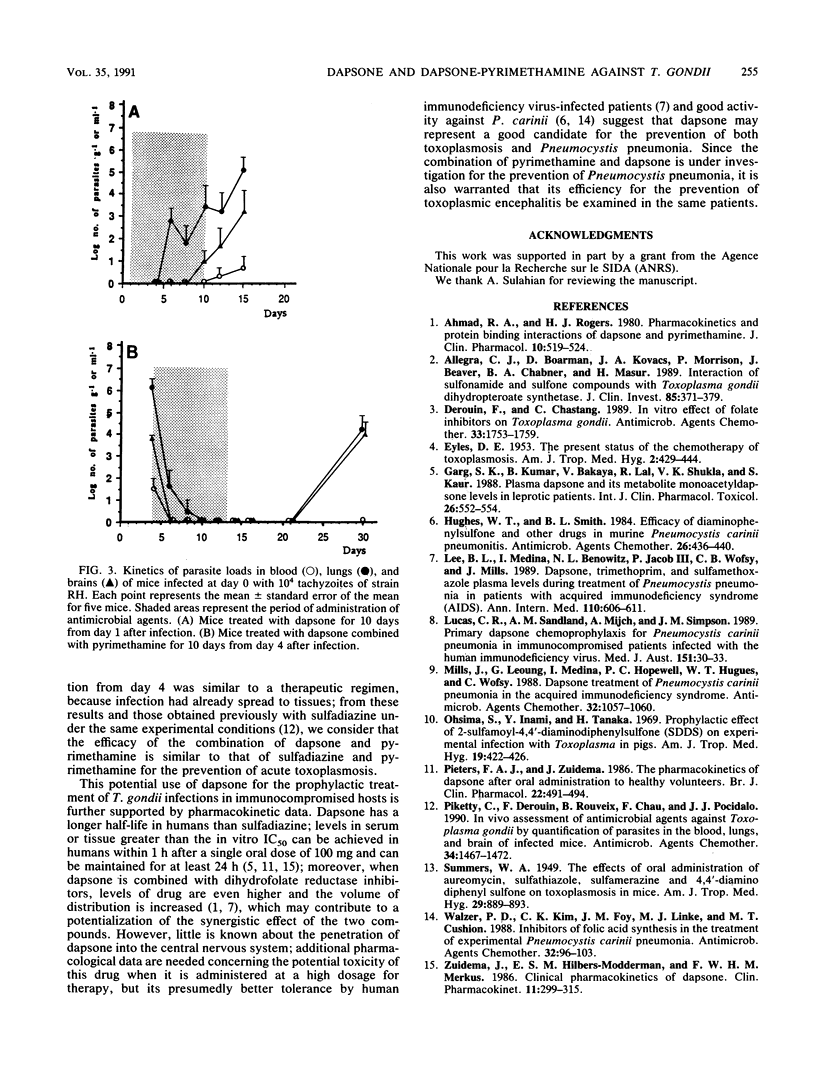Abstract
The efficacy of dapsone alone or combined with pyrimethamine against Toxoplasma gondii was investigated experimentally. For in vitro studies, a sensitive immunoassay was used for assessment of Toxoplasma growth in tissue cultures; dapsone was found to have a significant inhibitory effect at a concentration of 0.5 micrograms/ml in the cultures, and the 50% inhibitory concentration was estimated to be 0.55 micrograms/ml. When pyrimethamine and dapsone were combined, an important synergistic effect which was associated with morphological alterations of the parasites was observed. In vivo studies were performed in a murine model of acute toxoplasmosis in which a tissue culture method was used to estimate the parasite burden in the blood, lungs, and brains of infected mice. Dapsone alone, which was administered at 100 mg/kg/day for 10 days from day 1 after infection, was unable to prevent parasite dissemination and only delayed the time to death of treated mice compared with the time of death of untreated controls. When dapsone and pyrimethamine (18.5 mg/kg/day) were administered in combination from day 4 after infection, parasites were cleared from blood and organs within 6 days, but relapses were observed 15 days after the cessation of therapy. When treatment was started at day 1 after infection, 100% of mice survived and relapses were not observed, suggesting a good efficacy of this combination for preventive therapy.
Full text
PDF



Selected References
These references are in PubMed. This may not be the complete list of references from this article.
- Ahmad R. A., Rogers H. J. Pharmacokinetics and protein binding interactions of dapsone and pyrimethamine. Br J Clin Pharmacol. 1980 Nov;10(5):519–524. doi: 10.1111/j.1365-2125.1980.tb01798.x. [DOI] [PMC free article] [PubMed] [Google Scholar]
- Allegra C. J., Boarman D., Kovacs J. A., Morrison P., Beaver J., Chabner B. A., Masur H. Interaction of sulfonamide and sulfone compounds with Toxoplasma gondii dihydropteroate synthase. J Clin Invest. 1990 Feb;85(2):371–379. doi: 10.1172/JCI114448. [DOI] [PMC free article] [PubMed] [Google Scholar]
- Derouin F., Chastang C. In vitro effects of folate inhibitors on Toxoplasma gondii. Antimicrob Agents Chemother. 1989 Oct;33(10):1753–1759. doi: 10.1128/aac.33.10.1753. [DOI] [PMC free article] [PubMed] [Google Scholar]
- EYLES D. E. The present status of the chemotherapy of toxoplasmosis. Am J Trop Med Hyg. 1953 May;2(3):429–444. doi: 10.4269/ajtmh.1953.2.429. [DOI] [PubMed] [Google Scholar]
- Garg S. K., Kumar B., Bakaya V., Lal R., Shukla V. K., Kaur S. Plasma dapsone and its metabolite monoacetyldapsone levels in leprotic patients. Int J Clin Pharmacol Ther Toxicol. 1988 Nov;26(11):552–554. [PubMed] [Google Scholar]
- Hughes W. T., Smith B. L. Efficacy of diaminodiphenylsulfone and other drugs in murine Pneumocystis carinii pneumonitis. Antimicrob Agents Chemother. 1984 Oct;26(4):436–440. doi: 10.1128/aac.26.4.436. [DOI] [PMC free article] [PubMed] [Google Scholar]
- Lee B. L., Medina I., Benowitz N. L., Jacob P., 3rd, Wofsy C. B., Mills J., 5th Dapsone, trimethoprim, and sulfamethoxazole plasma levels during treatment of Pneumocystis pneumonia in patients with the acquired immunodeficiency syndrome (AIDS). Evidence of drug interactions. Ann Intern Med. 1989 Apr 15;110(8):606–611. doi: 10.7326/0003-4819-110-8-606. [DOI] [PubMed] [Google Scholar]
- Lucas C. R., Sandland A. M., Mijch A., Simpson J. M. Primary dapsone chemoprophylaxis for Pneumocystis carinii pneumonia in immunocompromised patients infected with the human immunodeficiency virus. Med J Aust. 1989 Jul 3;151(1):30–33. doi: 10.5694/j.1326-5377.1989.tb128450.x. [DOI] [PubMed] [Google Scholar]
- Mills J., Leoung G., Medina I., Hopewell P. C., Hughes W. T., Wofsy C. Dapsone treatment of Pneumocystis carinii pneumonia in the acquired immunodeficiency syndrome. Antimicrob Agents Chemother. 1988 Jul;32(7):1057–1060. doi: 10.1128/aac.32.7.1057. [DOI] [PMC free article] [PubMed] [Google Scholar]
- Oshima S., Inami Y., Tanaka H. Prophylactic effect of 2-sulfamoyl-4,4'-diaminodiphenylsulfone (SDDS) on experimental infection with Toxoplasma in pigs. Am J Trop Med Hyg. 1970 May;19(3):422–426. doi: 10.4269/ajtmh.1970.19.422. [DOI] [PubMed] [Google Scholar]
- Pieters F. A., Zuidema J. The pharmacokinetics of dapsone after oral administration to healthy volunteers. Br J Clin Pharmacol. 1986 Oct;22(4):491–494. doi: 10.1111/j.1365-2125.1986.tb02924.x. [DOI] [PMC free article] [PubMed] [Google Scholar]
- Piketty C., Derouin F., Rouveix B., Pocidalo J. J. In vivo assessment of antimicrobial agents against Toxoplasma gondii by quantification of parasites in the blood, lungs, and brain of infected mice. Antimicrob Agents Chemother. 1990 Aug;34(8):1467–1472. doi: 10.1128/aac.34.8.1467. [DOI] [PMC free article] [PubMed] [Google Scholar]
- SUMMERS W. A. The effects of oral administration of aureomycin, sulfathiazole, sulfamerazine and 4,4'-diamino diphenyl sulfone on toxoplasmosis in mice. Am J Trop Med Hyg. 1949 Nov;29(6):889–893. doi: 10.4269/ajtmh.1949.s1-29.889. [DOI] [PubMed] [Google Scholar]
- Walzer P. D., Kim C. K., Foy J. M., Linke M. J., Cushion M. T. Inhibitors of folic acid synthesis in the treatment of experimental Pneumocystis carinii pneumonia. Antimicrob Agents Chemother. 1988 Jan;32(1):96–103. doi: 10.1128/aac.32.1.96. [DOI] [PMC free article] [PubMed] [Google Scholar]
- Zuidema J., Hilbers-Modderman E. S., Merkus F. W. Clinical pharmacokinetics of dapsone. Clin Pharmacokinet. 1986 Jul-Aug;11(4):299–315. doi: 10.2165/00003088-198611040-00003. [DOI] [PubMed] [Google Scholar]


